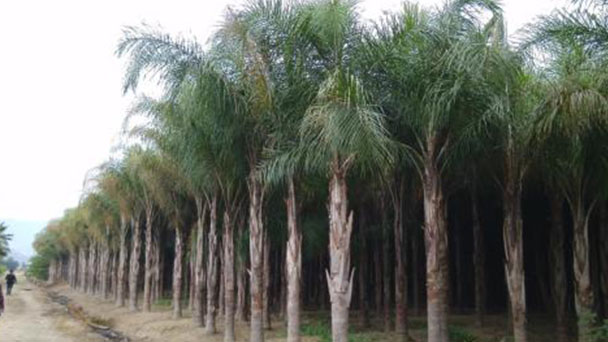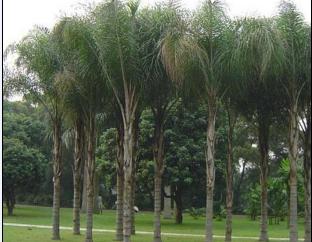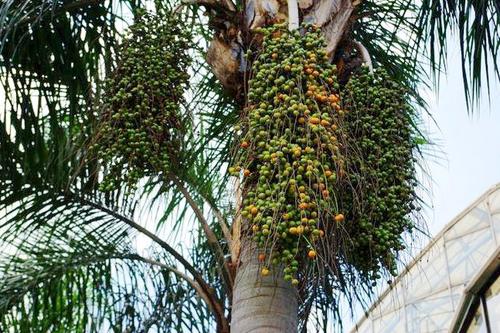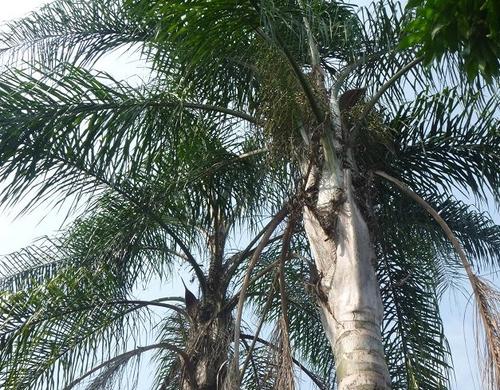Queen Palm (Syagrus Romanzoffiana) Profile: Care & Planting Guide
Written by Maggie
Nov 01 2021

Queen Palm Tree, scientific name Syagrus romanzoffiana, is a member of the palm family. Queen Palm Tree is produced in Brazil, Argentina, Bolivia and other countries, the southern region of China has long been introduced to cultivation. Queen Palm Tree likes a warm, moist, sunny environment, requires a deep soil layer, loose soil quality, and good drainage soil. The suitable temperature for its growth is 22 ~ 28℃, and it can withstand the low temperature below 0℃ for a short time. Queen Palm Tree can be used as ornamental trees or street trees, and also as coastal greening materials.
Queen Palm Tree Picture

Characteristics of Queen Palm Tree
Queen Palm Tree is arbor shaped, with a dry height of 10-15 m and a diameter of 20-40 cm. Ye Yu all crack, 4-5 meters long, pinna, every 2 to 5 pieces close to the group arranged in several columns, slightly interval, between each group of linear lanceolate, biggest feather grows 95-100 cm, ca. 4 cm wide, at the top of the alienation, short, narrow linear (about 2 cm wide), with one obvious midrib, transverse veins thin, dense, without a thorn, the two sides and edges on the back of the scales on midrib abortive, pinna apex shallow crack; Petioles and axles of Queen Palm Tree covered with brown scaly tomentose that is easily detached. Inflorescences in axils of leaves, up to 1 m long, once branched, up to 80 or more branches, each 30-50 cm long, zigzag curved, with female flowers from the base to the middle, male flowers at the top; Large bracts (spatula of peduncle) of Queen Palm Tree are navicular, lignified, 150 cm long and 14 cm wide, long beaked at tip, longitudinally furrowed abaxially; Flowers are monoecious; Male flowers of Queen Palm Tree are 7-16 mm long (shorter apically); Female flowers are 4.5 -- 6 mm long and 4 -- 6 mm wide. Fruit of Queen Palm Tree is subglobose or obovoid, 3 cm long and 2.7 cm in diameter, slightly beaked, exocarp smooth, orange yellow when fresh, brown after dry, mesocarp fleshy with fibrous, endocarp thick, bony, hard, endocarp cavity irregularly shaped, with 3 germination holes near base. Seeds of Queen Palm Tree are homomorphic with endocarp lumen, endosperm evenly angular, with a small central cavity, embryo subbasal.
Habits of Queen Palm Tree
Queen Palm Tree likes a warm, moist, sunny and ventilated environment. Its growth temperature is 22-28 degrees Celsius, and it can withstand the low temperature of -2 degrees Celsius and the low temperature of -5 degrees Celsius for a short time. Queen Palm Tree requires fertile and moist soil, strong wind resistance, salt and alkali resistance and drought resistance.
Queen Palm Tree prefers warm, moist and sunny environments, requiring a deep soil layer, loose soil quality and good drainage. Its growth temperature 22-28 degrees, can withstand the low temperature below 0 degrees. Less occurrence of diseases and insect pests. Queen Palm Tree is resistant to hot sun, also slightly shade. Queen Palm Tree is a pleasant soil layer deep, fertile moist as the base fertilizer, every year to apply nitrogen fertilizer 1~2 times, can keep the leaf green, and does not appear dry yellow. Spring, summer, autumn 3 seasons should cover the sun 50% or so, not in strong sunshine under the direct bask, otherwise can make blade dry edge, coke tip, lose ornamental value.In winter, it can be placed indoors in direct sunlight.
Queen Palm Tree is beautiful in shape, prefers shade, and likes warm and moist environments. The soil must be moist during the growing season and there must be adequate air humidity around the plant. Queen Palm Tree with loose tails are afraid of the cold and have poor cold resistance. potted queen palm Tree placed in the shade on the open ground must be moved indoors in late September for the winter season
It is better to keep the room temperature at about 25℃ in the daytime, and the room temperature at night should be kept above 15℃, or at least above 10℃. If it is lower than 5℃ for a long time, it will be subjected to freezing damage. During the winter, we must also pay attention to often scrub the foliage or spray a small amount of water to the foliage, to clean the foliage, keep the foliage fresh and bright to improve the ornamental effect.
How to Grow and Care for Queen Palm Tree
[Soil]: Queen Palm Tree has strong growth potential, developed root system, soil conditions are not strict requirements, potted, available garden soil and humus soil equal amount of mixing as a substrate. Generally every 1-2 years for a basin, the part of the old soil is removed when the basin is changed, the part of the old root is cut off, and the new soil is planted again, and a small amount of putrid organic fertilizer is filled.
[Temperature]: The suitable temperature for Queen Palm Tree growth is 18-30 degrees, and the overwintering temperature is 3 degrees. Queen Palm Tree can bear the low temperature of -1 -- 2 degrees for a short time, and it will be subjected to freezing damage if the temperature is lower than this for a long time.
[Light]: For light-loving plants, the growing period should be full of sunshine, Queen Palm Tree has a strong ability to adapt to the light, and is also suitable for indoor light cultivation and ornamental.
[Watering]: The root is half fleshy, Queen Palm Tree has a strong drought resistance ability, in 3-October growing season, can be watered 1 times a day, other seasons watering to grasp the dry and wet moderate, avoid basin soil water, so as not to cause root rot. Just keep the soil moist during dormancy, and spray water on the leaves in dry climates to ensure that the leaves are dark green and shiny.
[Fertilization]: During the growing period, liquid fertilizer or compound fertilizer is usually applied every month 1-2 times to promote the vigorous growth of plants.
[Potting and repotting] potted or for pot, add a small amount of decaying cake fertilizer as the base fertilizer, every 15 days during the growing season, stop fertilizing after the beginning of autumn; Queen Palm Tree grows fast and has developed root system, so it should be changed once a year in early spring. During the change, part of the old roots should be cut off, the old yellow leaves at the base of the plant should be cut off, and some new culture soil should be replaced, which is conducive to growth.
Queen Palm Tree Winter Care for Young Plants Young palms are especially vulnerable to cold damage because they haven’t developed deep enough root systems to ensure the base of the plant survives. Plants in containers can be brought indoors for winter. Those in the ground should be mulched around the base. For extra protection when a freeze is due, put a bucket or garbage can over the crown with holiday lights inside. The lights emit just enough warmth and the covering keeps heavy snow and icy winds from the fronds. How to Overwinter Queen Palm Trees Winterizing Queen Palm Tree trees is essential if your region ever expects freezing temperatures. The young plants are easy to protect, but the big mature beauties are much more difficult. Holiday or rope lights help add ambient warmth. Wrap the trunk and the fronds. To make this more effective, build a scaffold around the plant. Then you can cover the entire plant in frost barrier fabric. This is an important part of Queen Palm Tree winter care where even an extended frost can cost the plant much of its vitality. A product also exists that is a spray on protection. Whichever method you choose, follow in late summer to early fall with an appropriate fertilizer. Well-nourished trees are much hardier than nutrient deprived tissues.

Queen Palm Tree Propagation
For large perennial plants, the root tillers of Queen Palm Tree can also be used to divide and propagate, because this is the only common cultivated Queen Palm Tree, and no fruit has been found in China. The root of the budding tiller buds cut off separate planting, such as Nie buds without roots, can be inserted into the sand, maintain a certain humidity, temperature maintained at about 25℃, a month later can take root.
Queen Palm Tree is usually divided every three years or so. In spring with change of soil in the basin basin, from within the basin of the original tuo ke to soil, shake off the soil Chen, choose tillering more plants, with a sword or branches cut from the base joint will be divided into plant plexus, mature had better have two or more tillers buds, and maintain a beautiful shape, the basin respectively, placed in 20 ℃ about indoor, after 1 to 2 years of careful maintenance, can become the new plants.
Disease Control of Queen Palm Tree
Summer rainy hot season, easy to catch downy mildew, can spray 1000 times of methyl tobujin prevention and control, found that scale insects can be used to kill oxidized diethoate spray.
Queen Palm Tree Varieties
Golden horseradish: Evergreen tree, stem slightly swollen and ringed below middle.Leaves 1 pinnately divided.Edible fruit.
Golden horseradish is also known as horseradish, golden hill coconut, horseradish is an evergreen tree, plant height can reach 1 meters above.In the north, except in the greenhouse of the botanical garden, most of them are container cultivated seedlings with a plant height of 0.3 meters, and single plant is ornamental. The root is brown yellow to yellow, the root cap is white, the root system is rich and developed, the lignification inside.Leaf-blade odd-pinnately divided, 2-5 m long. Petiole and axis are abaxially semi-orbicular, abaxially flat or slightly furred, and are covered with grayish scales and batchlike hairs that are easy to fall off. Lobes lanceolate, 30 -- 90 cm long, 2 -- 3.5 cm wide. The leaves and lobes of the northern container seedlings were shorter than those of the greenhouse seedlings. Leaf apex acuminate into 2 lobes, main veins protruding, lobes valgus. Inflorescences and branches conical in middle leaf axils or on defoliated trunks.Involucral bracts l, woody, navicular, 150 cm long. The flowers are monoecious. Single, male flowers on upper part of inflorescence, female flowers on lower part, pale yellow flowers, obovate fruit, ca. 3 cm long, 2 cm in diameter.
Queen Palm Tree's Distribution
Queen Palm Tree was originally made in Brazil.
Queen Palm Tree is widely cultivated in tropical and subtropical regions. The southern provinces of China are commonly cultivated in gardens and garden units, mostly for garden viewing, edible fruit.
Garden use of Queen Palm Tree
Queen Palm Tree is fluffy and natural in tree shape, showing vigor and vitality, and is strong and independent. In the palm class, another scene, for the display of tropical scenery, is common tree species. Queen Palm Tree can be street trees, garden trees, or single plant in front of the two sides, or irregularly planted in the waterfront, lawn periphery, and Phoenix trees and other flowers and trees configuration planting, can add garden scenery.
The saplings are planted in large pots, which can be used as exhibition halls, meeting rooms, waiting rooms, etc., for the beautiful leaf-viewing bonsai. Queen Palm Tree can be used as both garden ornamental tree and coastal greening material. Queen Palm Tree seeds can be used to make necklaces, and pollen is a good source of nectar. queen palm tree seeds are beautiful. Queen Palm Tree is a tall and graceful tree with a head diameter of 40-50 cm and can grow to 5-8 meters in 15 years. It is a very precious urban garden greening variety and is also commonly used as a street tree.

Latest Updated
- Benefits of Bugleweed - 7 Science-backed Health Benefits
- Bugleweed Dangers & Side Effects - Is It Poisonous?
- How to Plant Evergreen Trees - What You Should Know
- When to Plant Evergreens - Grow Guide for Evergreen Trees
- 12 Wonderful Evergreen Shrubs for Your Garden
- 12 Popular Evergreen Plants with Pictures for Beginners
- When And How To Prune A Lilac Bush Like a Pro
- How to Grow & Care for Lilac Vine (Hardenbergia Violacea)
- Japanese Lilac Tree (Syringa Reticulata) Care & Propagation Guide
- Shumard Oak Pros and Cons - What to Know
Popular Articles
- Winter maintenance of Antirrhinum Majus
- How to Grow Terminalia Mantaly Tree
- How to Grow and Care for Crossostephium Chinense
- How to grow Antirrhinum Majus in spring
- Peristeria Elata (Dove Orchid) Profile: Info & Care Guide
- Underwatered Snake Plant (Sansevieria Trifasciata) - Signs And How To Fix
- How to Care for Brazilian Jasmine Plant (Mandevilla Sanderi)
- How to Grow & Care for Graptopetalum Purple Delight in Summer
- Rosa Chinensis (China Rose): Plant Growing & Care Tips
- How to Care for Baby Sun Rose (Aptenia Cordifolia)